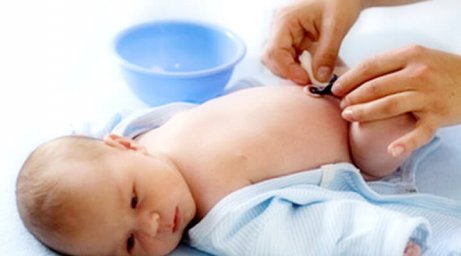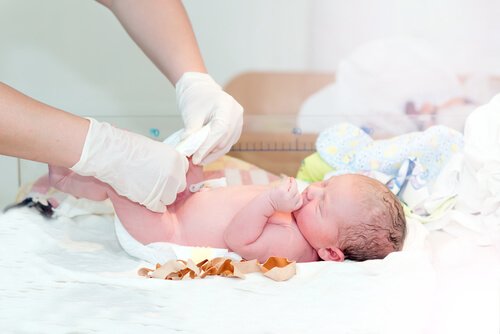How to Care for Your Newborn's Umbilical Cord Stump

In today’s article, we’ll tell you how to care for your newborn baby’s umbilical cord stump.
Once born, babies no longer need the link that kept them alive during their nine months in the womb. However, a small portion of the umbilical cord stays attached for several days.
Caring for your newborn baby’s umbilical cord stump
While babies are in their mother’s womb, the blood vessels in the umbilical cord allow for the entry of microorganisms and nutrients. From the time a baby is born, medical personnel cut the cord between mother and child.
The small stump left behind on the baby’s belly button is sealed with a clip that shouldn’t be removed. Rather, the stump will fall off on its own in about 8 to 15 days. When this occurs, another week will go by before the area heals completely.
Many first-time mothers aren’t sure how to care for the umbilical cord once their babies are born. And it might surprise you to know that there’s not just one right answer.
Some recommend cleaning the area with alcohol, while others suggest antiseptic.
At the same time, some affirm that you should just leave the area alone. According to this theory, the area will heal on its own without the need for intervention.
Is it okay to use products like antiseptics?
Umbilical cords have the ability to spread bacteria. For this reason, doctors have recommended the use of antiseptics to avoid infection for decades.
However, a good number of professionals claim that antiseptics aren’t the best route. Rather, they recommend keeping the area clean and dry. The use of additional products can delay the falling off of the stump, and there’s no benefit to that.

So, how then should parents care for the umbilical cord stump? A good option is to use disinfectants, but without going overboard. Most recommend using 70% isopropyl alcohol and chlorhexidine – a transparent liquid antiseptic – to avoid infections.
Keep in mind that, until the umbilical cord stump falls off, the area needs to stay dry, protected and covered.
During the first days of your baby’s life, he or she won’t need a bath. You can simply clean the rest of your baby’s body with a damp cloth, avoiding the belly button area.
Step by step instructions for cleaning the umbilical cord stump
A good time to care for your child’s umbilical cord stump is during diaper changes. This is something you’ll be doing multiple times per day. So, pick a time of day (for example, morning or night) to clean your baby’s umbilical cord stump during a diaper change.
To complete this task, you’ll need sterile gauze or bandages, 70% isopropyl alcohol or chlorhexidine. Iodine and similar substances aren’t recommended, as they stain and don’t allow us to observe the wound’s evolution.
Wash your hands thoroughly with water and neutral soup before handling the gauze that wraps around the cord and clamp. If the gauze is stuck to the cord, don’t pull. Rather, dampen the area with antiseptic and then remove.
Instructions
First, take gauze and dampen with antiseptic. Gently pat the entire area, including the belly button and surrounding skin. Then, dry well with another gauze.
It’s very important that you don’t use cotton, as fuzz may be left behind. This can produce infection or delay the scarring process.
“Until the umbilical cord stump falls off, the area needs to stay dry, protected and covered.”

Next, place another alcohol soaked gauze and wrap it around the cord, and then place a bandage on the area. Finally, clean your baby’s genital area.
When putting on his or her diaper, be sure not to cover the cord. That way, the area will get some air circulation. If it’s summer and temperatures are high, you can leave your baby in just a diaper to speed up the process.
If you do decide to dress your baby, be sure to choose items made of cotton to cover the area. Try to make sure the area doesn’t rub against anything when your baby is nursing or sleeping. Repeat this process two to four times each day.
Following these instructions, you shouldn’t have any difficulties. However, you should consult with your pediatrician if the belly button bleeds abundantly, smells bad, the base of the cord seeps, or you observe a small soft lump.
Also, if the cord stump hasn’t fallen off within three weeks of your baby’s birth, you should talk with your pediatrician.
All cited sources were thoroughly reviewed by our team to ensure their quality, reliability, currency, and validity. The bibliography of this article was considered reliable and of academic or scientific accuracy.
- Díaz Gutiérrez, M. (2016). Cuidados del cordón umbilical en el recién nacido: revisión de la evidencia científica. Ars Pharmaceutica (Internet), 57(1), 5-10. http://scielo.isciii.es/pdf/ars/v57n1/revision1.pdf
- Doménech, E., González, N., & Rodríguez-Alarcón, J. (2008). Cuidados generales del recién nacido sano. Madrid: Asociación Española de Pediatría. https://www.seneo.es/Portals/0/Articulos/2.pdf
- Noguera Ortiz, N. Y., & Rodríguez Rodríguez, M. R. (2008). Aprendiendo a cuidar al recién nacido: un cuidado congruente con la cultura. Avances en Enfermería; Vol. 26, núm. 1; 103-111 23460261 01214500. http://www.bdigital.unal.edu.co/17273/
- Peinado-Jaén R. (2014). Cuidados del Cordón Umbilical: Revisión de la evidencia. (2014).
- Sánchez Luna M, Pallás Alonso CR, Botet Mussons F, Echá-niz Urcelay I, Castro Conde JR, Narbona E. (2009). Recomendaciones para el cuidado y atención del recién nacido sano en el parto y en las primeras horas después del nacimiento. An. Pediatría. 2009;71:349–361
This text is provided for informational purposes only and does not replace consultation with a professional. If in doubt, consult your specialist.








